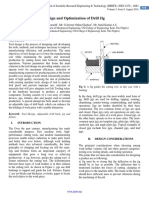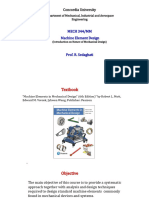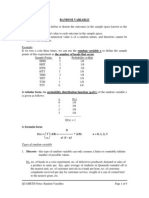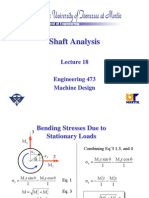Machine Design Project
Uploaded by
Andrew TanMachine Design Project
Uploaded by
Andrew TanClass Project Spring 2002 Engineering 473 - Machine Design
You are to design a speed reducer for an industrial saw that is used to cut bar stock. The saw will be driven by a 30 hp electric motor rotating at 1,750 rpm. The drive shaft for the saw should rotate at approximately 400 rpm (395 405 rpm is an acceptable range). The NEMA frame 286T motor will have a shaft diameter of 1.875 in and a keyway to accommodate a 1/2x1/2 in key. The following table and figure provide information about the motor. The saw is a band saw and generally operates in a smooth manner, but moderate shock may be encountered as the saw blade engages the stock or if there is any binding of the blade in the cut. The minimum input torque to the saw should be 3,500 in-lb. The speed reducer will be mounted on a rigid plate that is part of the base of the saw. The means of mounting the reducer should be specified. Flexible couplings may be used to connect the motor shaft to the input shaft of the reducer and to connect the output shaft directly to the shaft of the main drive wheel for the band saw. The design of the band-saw shaft has not been completed. It is likely that its diameter will be the same as that of the output shaft of the reducer. A compact size for the reducer is desirable, but space in the machine base should be able to accommodate most reasonable designs. The factory owner is concerned about the cost of building the speed reducer, and the cost should be considered when making design decisions. The saw is expected to operate 16 hours per day, 5 days per week, with a design life of 5 years. This is approximately 20,000 hours of operation. The factory environment will have a temperature range from 50oF to 100oF. The machine base will be enclosed and will prevent any unusual contact with the reducer. However, the functional components of the reducer should be enclosed in their own rigid housing to protect them from contaminants and to provide for the safety of those who work with the equipment. You are required to size all components, create an assembly drawing showing how all components fit together (shafts, housing, bearings, gears, pulleys, sprockets, fasteners, etc.), and create detailed fabrication drawings for any shafts that will be required. Materials for all parts to be fabricated must be called out. An example shaft drawing (without border) is shown in the class notes. Either Ideas or AutoCAD may be used. Solid modeling is encouraged. A stress report must be submitted that shows that all parts are adequately sized and will meet all strength and life requirements. The owner is not interested in legal problems if your design results in premature failure and injury to plant workers.
You will be graded on 1) completeness, 2) ease of assembly, 3) manufacturability, 4) drawing quality, 5) technical correctness, and 6) professional quality of report.
You might also like
- Shaft Design (Mini Project 2) Machine Design Project100% (5)Shaft Design (Mini Project 2) Machine Design Project26 pages
- Intelligent Braking System Literature ReviewNo ratings yetIntelligent Braking System Literature Review39 pages
- ME 397 - Precision Machine Design: Spring 2015No ratings yetME 397 - Precision Machine Design: Spring 201510 pages
- L-3/T-2/ME Date:08/12/2014: Section-A Four ThreeNo ratings yetL-3/T-2/ME Date:08/12/2014: Section-A Four Three26 pages
- Machine Design Mini Project, Sem I 2018 2019No ratings yetMachine Design Mini Project, Sem I 2018 20192 pages
- INME 4011 Term Project Guideline: D&T OnlineNo ratings yetINME 4011 Term Project Guideline: D&T Online9 pages
- MECH344_Lecture-1 Introduction to Nature of DesignNo ratings yetMECH344_Lecture-1 Introduction to Nature of Design16 pages
- Group 5 Lathe Final Report: 1.1 Spindle and Spindle HousingNo ratings yetGroup 5 Lathe Final Report: 1.1 Spindle and Spindle Housing15 pages
- MIET2510 Mechanical Design - Practical Assignment 2No ratings yetMIET2510 Mechanical Design - Practical Assignment 214 pages
- MDB-Aero Engine Gearbox Specification) 2024-25No ratings yetMDB-Aero Engine Gearbox Specification) 2024-259 pages
- Jithin S Nair Shine Rajan Lijin Jose Manu GopinadhNo ratings yetJithin S Nair Shine Rajan Lijin Jose Manu Gopinadh28 pages
- Mem706 - Mechanical Engineering Design-IiNo ratings yetMem706 - Mechanical Engineering Design-Ii11 pages
- Design of Transmission Systems - Important QuestonsNo ratings yetDesign of Transmission Systems - Important Questons5 pages
- Machine Design-I: Instructio N To CandidatesNo ratings yetMachine Design-I: Instructio N To Candidates2 pages
- Manufacturing Analysis Continuous AssessmentNo ratings yetManufacturing Analysis Continuous Assessment25 pages
- A Process Capability Improvement of Machining Parameters of Ten Ton Compactor'S Rear ChassisNo ratings yetA Process Capability Improvement of Machining Parameters of Ten Ton Compactor'S Rear Chassis10 pages
- Gear Reducers: Design Notes For Course Project On Gear Reducer DesignNo ratings yetGear Reducers: Design Notes For Course Project On Gear Reducer Design60 pages
- The Ford SOHC Pinto & Sierra Cosworth DOHC Engines high-peformance manual: For Road & TrackFrom EverandThe Ford SOHC Pinto & Sierra Cosworth DOHC Engines high-peformance manual: For Road & TrackNo ratings yet
- How to Power Tune the BMC/BL/Rover 998 A-Series Engine for Road and TrackFrom EverandHow to Power Tune the BMC/BL/Rover 998 A-Series Engine for Road and TrackNo ratings yet
- A DIY'ers Definitive Guide to Building a Custom Volkswagen TrikeFrom EverandA DIY'ers Definitive Guide to Building a Custom Volkswagen TrikeNo ratings yet
- Agricultural Robots - An Economic Feasibility StudyNo ratings yetAgricultural Robots - An Economic Feasibility Study8 pages
- Const Int Const Int: Ledpin 13 Buttonpin 17No ratings yetConst Int Const Int: Ledpin 13 Buttonpin 172 pages
- Brush Erosion-Dissolution Mechanical MachiningNo ratings yetBrush Erosion-Dissolution Mechanical Machining8 pages
- Vertical Farming: The Future of AgricultureNo ratings yetVertical Farming: The Future of Agriculture12 pages
- Shielded Metal Arc Welding: By: Charles Lu Derwin Li Andrew Tan Renz Raquion Emil WangNo ratings yetShielded Metal Arc Welding: By: Charles Lu Derwin Li Andrew Tan Renz Raquion Emil Wang44 pages
- Shielded Metal Arc Welding: By: Charles Lu Derwin Li Andrew Tan Renz Raquion Emil WangNo ratings yetShielded Metal Arc Welding: By: Charles Lu Derwin Li Andrew Tan Renz Raquion Emil Wang44 pages
- HIS 1.4 Centrifugal Pumps Installation Operation100% (3)HIS 1.4 Centrifugal Pumps Installation Operation66 pages
- GEH-2304G DC Motors & Generators Type CD Frames 180-680100% (1)GEH-2304G DC Motors & Generators Type CD Frames 180-68016 pages
- Shaft Alignment and Couplings - Course Sample - 596133-603909No ratings yetShaft Alignment and Couplings - Course Sample - 596133-60390935 pages
- Project - Report - On - Ammonia - Mechanical by Mridul JainNo ratings yetProject - Report - On - Ammonia - Mechanical by Mridul Jain39 pages
- If A Coupling Has Two Concentric Rows of Bolts, The Torque Capacity IsNo ratings yetIf A Coupling Has Two Concentric Rows of Bolts, The Torque Capacity Is19 pages
- Basic Electric Motor Maintenance: Ed Robinson Regional Service Manger100% (2)Basic Electric Motor Maintenance: Ed Robinson Regional Service Manger48 pages
- Xcentric Ripper Series Instruction Manual English (109E) PDF100% (1)Xcentric Ripper Series Instruction Manual English (109E) PDF85 pages
- Engineered Air and Gas Compressors - LetterNo ratings yetEngineered Air and Gas Compressors - Letter24 pages
- 2003 Nissan Altima 2.5 Serivce Manual MTNo ratings yet2003 Nissan Altima 2.5 Serivce Manual MT66 pages
- Mechanical Engineering Drawing 0-0-3: Code: Credit: 03 L-T-PNo ratings yetMechanical Engineering Drawing 0-0-3: Code: Credit: 03 L-T-P1 page
- 2-1 - R 23 - Computer Aided Machine Drawing Lab ManualNo ratings yet2-1 - R 23 - Computer Aided Machine Drawing Lab Manual51 pages
- Taner Industrial Technology (M) Sdn. BHDNo ratings yetTaner Industrial Technology (M) Sdn. BHD1 page
- Reciprocating Rod Lift Systems-Sucker Rods: Daniel RenteriaNo ratings yetReciprocating Rod Lift Systems-Sucker Rods: Daniel Renteria61 pages








































































































